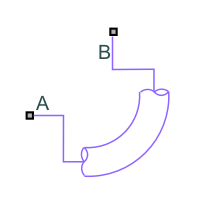Pipe Bend (MA)
Libraries:
Simscape /
Fluids /
Moist Air /
Pipes & Fittings
Description
The Pipe Bend (MA) block represents a curved pipe in a moist air network. You can define the pipe characteristics to calculate losses due to friction and pipe curvature. The block models losses with hydraulic loss coefficients and the results may be more accurate for lower speed flows where you can neglect compressible flow effects.
Pipe Curvature Loss Coefficient
The coefficient for pressure losses due to geometry changes comprises an angle correction factor, Cangle, and a bend coefficient, Cbend:
The block calculates Cangle as:
where θ is the value of the Bend angle parameter, in degrees.
The block calculates Cbend from the tabulated ratio of the bend radius, r, to the pipe diameter, d, for 90° bends from data based on Crane [1]:

| r/d | 1 | 1.5 | 2 | 3 | 4 | 6 | 8 | 10 | 12 | 14 | 16 | 20 | 24 |
|---|---|---|---|---|---|---|---|---|---|---|---|---|---|
| K | 20 fT | 14 fT | 12 fT | 12 fT | 14 fT | 17 fT | 24 fT | 30 fT | 34 fT | 38 fT | 42 fT | 50 fT | 58 fT |
The block interpolates the friction factor, fT, for clean commercial steel from tabular data based on the pipe diameter [1]. This table contains the pipe friction data for clean commercial steel pipe with flow in the zone of complete turbulence.
| Nominal size (mm) | 5 | 10 | 15 | 20 | 25 | 32 | 40 | 50 | 72.5 | 100 | 125 | 150 | 225 | 350 | 609.5 |
|---|---|---|---|---|---|---|---|---|---|---|---|---|---|---|---|
| Friction factor, fT | .035 | .029 | .027 | .025 | .023 | .022 | .021 | .019 | .018 | .017 | .016 | .015 | .014 | .013 | .012 |
The correction factor is valid for a ratio of bend radius to diameter between 1 and 24. Beyond this range, the block employs nearest-neighbor extrapolation.
Losses Due to Friction in Laminar Flows
The pressure loss formulations are the same for the flow at ports A and B.
When the flow in the pipe is fully laminar, or below Re = 2000, the pressure loss over the bend is
where:
μ is the relative humidity.
λ is the Darcy friction factor constant, which is 64 for laminar flow.
ρI is the internal fluid density.
d is the pipe diameter.
L is the bend length segment, which is the product of the Bend radius and the Bend angle parameters:
A is the pipe cross-sectional area,
is the mass flow rate at the respective port.
Losses due to Friction in Turbulent Flows
When the flow is fully turbulent, or greater than Re = 4000, the pressure loss in the pipe is:
where fD is the Darcy friction factor. The block approximates this value by using the empirical Haaland equation and the Internal surface absolute roughness parameter. The block takes the differential over each half of the pipe segment, between port A to an internal node, and between the internal node and port B.
Pressure Differential
The block calculates the pressure loss over the bend based on the internal fluid volume pressure, pI :
Mass and Energy Balance
The net flow rates into the moist air volume inside the pipe bend are
where:
is the mass flow rate. The subscript w denotes water vapor, the subscript g denotes trace gas, and the subscript d denotes water droplets.
λd is the value of the Fraction of condensate entrained as water droplets parameter.
w,cond is the rate of water vapor condensation due to a saturated fluid volume.
w,conv is the rate of condensation on the wall surface.
d,evap is the rate of water droplet evaporation.
Φ is the energy flow rate.
The mass conservation equations for the mixture relate the pressure, temperature, and internal moist air volume mass fractions
where:
pI is the pressure of the internal volume.
ρI is the density of the internal volume.
TI is the temperature of the internal volume.
V is the volume.
Ra, Rg, Rw, and RI are the specific gas constants of the air, gas, water vapor, and internal volume, respectively.
xw is the specific humidity.
xg is the trace gas mass fraction.
The energy conservation equation relates the energy flow rate to the pressure, temperature, and internal moist air volume mass fractions
where:
uI is the internal energy.
cpI is the specific heat.
rd is the mass ratio of water droplets to moist air.
cpdI is the water droplet specific heat.
is the total water droplet mass flow rate.
hdI is the water droplet specific enthalpy.
ϕA is the energy flow rate at port A.
ϕB is the energy flow rate at port B.
w,cond is the rate of water vapor condensation due to a saturated fluid volume.
λd is the value of the Fraction of condensate entrained as water droplets parameter.
ϕA is the energy flow rate at port A.
ϕB is the energy flow rate at port B.
The mass conservation equation for the water droplets relates the water vapor mass flow rate to the internal moist air volume moisture level
The trace gas mass conservation equation relates the trace gas mass flow rate to the internal moist air volume trace gas level
The water droplets mass conservation equation relates the water droplet mass flow rate to the entrained water droplet dynamics in the internal moist air volume
Ports
Conserving
Parameters
References
[1] Crane Co. Flow of Fluids Through Valves, Fittings, and Pipe TP-410. Crane Co., 1981.
